How to Look at Nature and Really See
Puddock Hill Journal #18: Take a field trip to your own backyard.
Nature is a great seductress. She calls our attention to what she wants us to see—the flashy flower, the bird’s colorful plumage, the neons of a coral reef—while camouflaging many other varieties of living and nonliving things.
I have recently come to the conclusion that allowing ourselves to be seduced in this way is something of a lazy habit. For the subjects of the backyard steward, it can even be fatal.
Of course, there is no harm in appreciating the beauty of garish flowers or bright butterflies, but if they become the exclusive target of our focus, we miss the myriad natural elements that sustain them—and us.
It has almost become cliché to bemoan the fact that so few in modern society know where their food comes from. Michael Pollan, in his bestselling book The Omnivore’s Dilemma, proposes that if factory farms had glass walls, the animals would be treated better. Seeing is knowing.
Similarly, what we don’t see can hurt us. We easily crush more subtle plants and animals underfoot on our way to the bigger show, for example. Just this week, the National Park Service declared a 380-foot-tall redwood off limits in Redwood National Park because overeager visitors were trampling the forest undergrowth around it.
Do we do the same things closer to home? I have no doubt that we do, and it is largely the result of looking without seeing.
One of the skills I acquired in graduate school, largely thanks to a wonderful instructor and naturalist named Sally Willig, was more carefully seeing that which grows and lives around me. This is an easy skill to cultivate, but it requires conscious effort. It begins with appreciating that the great vista glimpsed through a car window or even while standing atop a mountain lookout is not a single swath but a collection of individual plants, a seemingly obvious observation that leads to more complex questions. How do I tell those individuals apart? How do they relate to one another? What sustains them? What limits them?
Scientists are accustomed to asking questions of this kind, but not so much the layman. For stewards who want to promote nature in their backyard, learning to observe and distinguish are essential skills.
Here are 10 Ways to See the Nature Around You:
Look at the total landscape, the lay of the land. Is it flat or hilly or steep? Does it contain meadows or forests, deserts or wetlands?
Geology is destiny. Consider the formations that underly what you see. Scientists have divided the world into physiographic provinces defined by the physical features that resulted from ancient (and ongoing) geological processes. For example, here is a USDA map of the United States that distinguishes 25 provinces. At Puddock Hill, we are in the northern reaches of the Piedmont province, quite a different place from the nearby Valley and Ridge or Coastal Plain provinces.
Physiology and climate dictate soil types and ecological niches. What’s underneath that lawn of yours or the nearby forest floor? In addition to organic matter near the surface, lower soil horizons result from things like ancient volcanic activity, receding glaciers, or erosion of nearby rock formations. The ground’s porosity affects drainage or lack of drainage, which can vary from one part of your property or neighborhood to another. These factors, along with climate, play a big part in determining the ecological niches all around you.
Once you’re done looking at the big picture, start to home in on the individuals in your ecosystem. One way to identify plants is by their growth habits. Is it a non-woody herbaceous plant, a vine, a tree, a shrub? Within those categories, does it tend to grow tall or hug the ground? Does it spread wide or is it compact?
Look closely at the leaves. There are many distinguishing characteristics of leaves. A few to consider are whether the leaves are broad or needles, and if the former, whether the edges of the leaves are smooth or serrated. What is the shape of the leaf? What texture does the underside of the leaf have? How are the leaves arranged on the branches?
What kind of flowers does the plant have? Are they large or small? Prominent or barely visible at all? What color are they? When do they bloom? Where do they appear on the plant?
Look at the fruit that the plant produces (usually later in the season). Is it a berry or a seed head or a nut? What’s the color and size of the fruit? What animals eat the fruit?
With a few obvious exceptions, animals in the landscape tend to be harder to spot. Since we have so little foot traffic here at Puddock Hill, even animals that might be less shy at a public park are often elusive. I’m convinced that we have several kinds of turtles in the big pond, for example, but I can never get close enough to identify more than the Painted turtle (Chrysemys picta) for sure. I learned during a photo safari in Zimbabwe years ago that the best way to observe animals is to sit still and let them grow accustomed to your presence. Despite the many benches we have placed around the property, I’m usually too busy racing about to do this, but I should—and you probably should, too. You’ll likely be surprised by how much life is out there.
Once you’ve spotted the animals, you might undertake a deeper study of their behavior and perhaps alter your immediate environment to promote the health of certain species. For example, because we don’t have many naturally fallen logs in the big pond for turtles to bask on, we have put some rocks out into the water to form a small jetty for them to use. If there’s no local water around for your birds, you may want to think about introducing a birdbath (but make sure you keep it fresh). If you want your toads to thrive, make sure they have shade and places to hide from predators.
Finally, observe climatic conditions. If you’re a gardener, you already know about USDA Plant Hardiness Zones, but these zones are slowly migrating with climate change. When was the last time you looked at that USDA map? What do you see when you consider the weather in your backyard? Here at Puddock Hill, the winters have grown shorter and most of the year has grown wetter. In recent decades, annual precipitation in Eastern Pennsylvania has increased up to 20 percent, and extreme precipitation events have increased 70 percent since 1958. Observe how changes in temperature and precipitation are affecting the flora and fauna in your neck of the woods and think about how you might help nature adapt.
When I launched this newsletter, I committed to taking a daily walk around the property to document our efforts. I endeavor to look at Puddock Hill in these different ways and try to anticipate the needs of the life I’m stewarding. When I can’t identify a plant (which happens often), I use the identification app built into iPhone (just swipe up on your photo and tap “Look Up — Plant”), or I plug it into my iNaturalist app, where I also keep a list of native and interesting non-native species. In just the past month, I’ve flagged:
Chicory
White avens
Moth mullein
Carolina horsenettle
Rough bedstraw
Swamp agrimony
Common selfheal
White vervain
Reed canary grass
Wingleaf primrose-willow
Wild basil
Spotted Joe-Pye weed
Virginia mountain mint
Whorled mountain mint
Common St. John’s-wort
Culver’s root
Common bracken fern
Allegheny monkeyflower
Seedbox
Stickseed
Meadow evening primrose
Great blue lobelia
Virginia three-seed mercury
That’s not counting the trees or the plants we’ve introduced in the garden, nor more common plants noted earlier in the season, nor the things I could not yet identify.
One other aspect of learning to see is paying attention to the passage of time. Plants that look nondescript early in their lifecycle can suddenly turn flashy when in bloom—or at other points in their development—possibly making them easier to identify. Following these rhythms is another kind of seeing.
Our small springhouse is the oldest structure at Puddock Hill, built in the late Eighteenth century. It has not run dry once in the past decade and a half, even during the longest dry spells. The people who built and farmed this place knew how to read the land. They spent their lives seeing that which was right in front of them.
If we emulate that practice, we will all be better backyard stewards.
Speaking of observations, in feedback from readers I noted some confusion between the Monarch butterfly (Danaus plexippus) and the now more common Eastern tiger swallowtail (Papilio glaucus). This is a picture I snapped of a Monarch this week:
Here is an Eastern tiger swallowtail seen from the underside.:
The top of the swallowtail is brighter yellow, not at all orange, and the wings have “tails.” Note that both butterflies are visiting a native Clethra bush, a popular stop for them at this time of year. I hope to plant more of these next year.
Native Canada goldenrod (Solidago altissima) comes into bloom in the barn meadow:
Berries begin to ripen on the native Chokeberry (Aronia melanocarpa) that we planted in a new bed by the house last summer:
The Fleabane never stops around here. Asserting its beauty over an invasion of evil Porcelainberry, this one grows by the big pond dam:
Seed heads of White avens on the upper big pond path:
Nearby grows the biennial native Beggar’s lice (Hackelia virginiana):



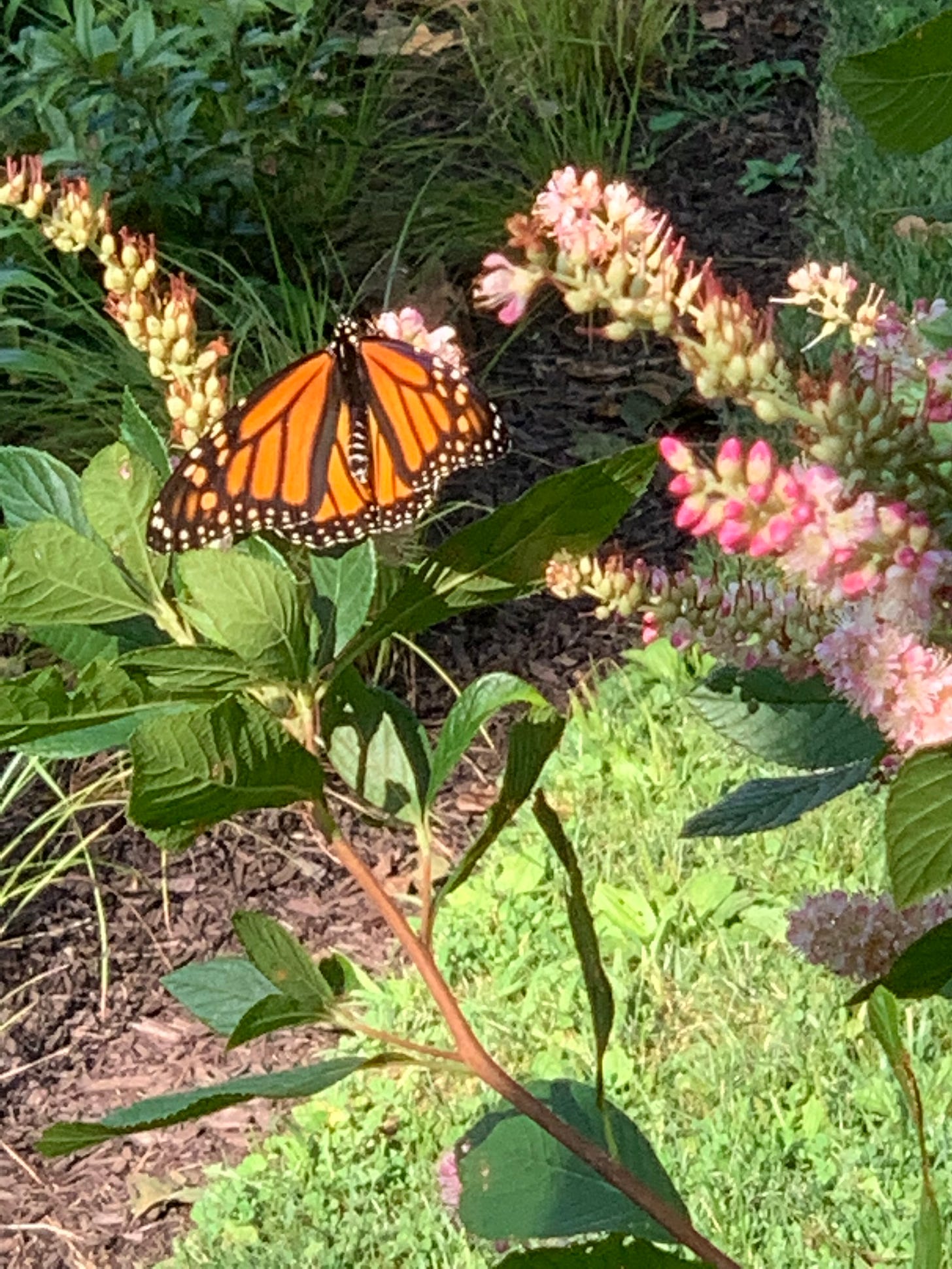
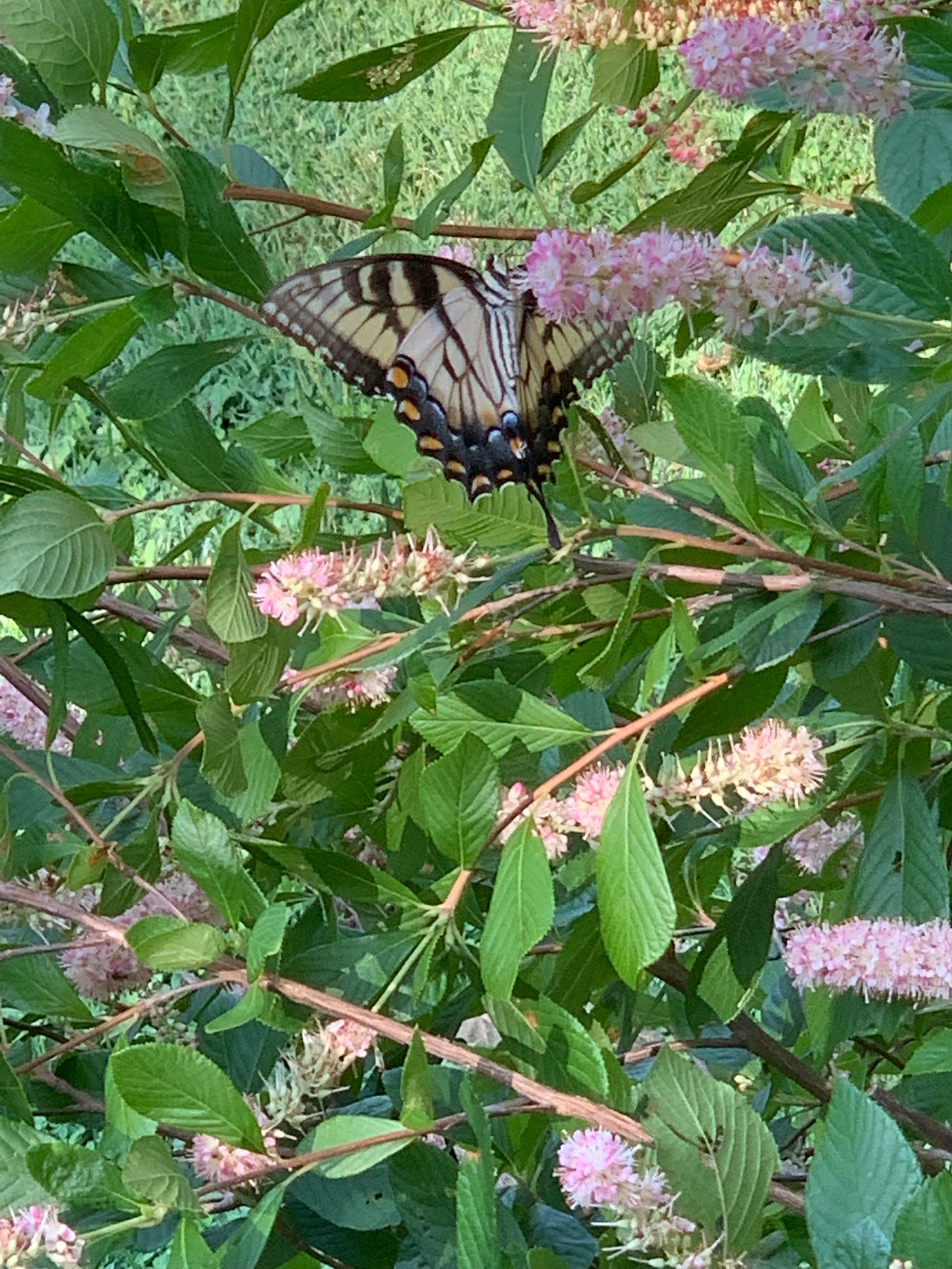
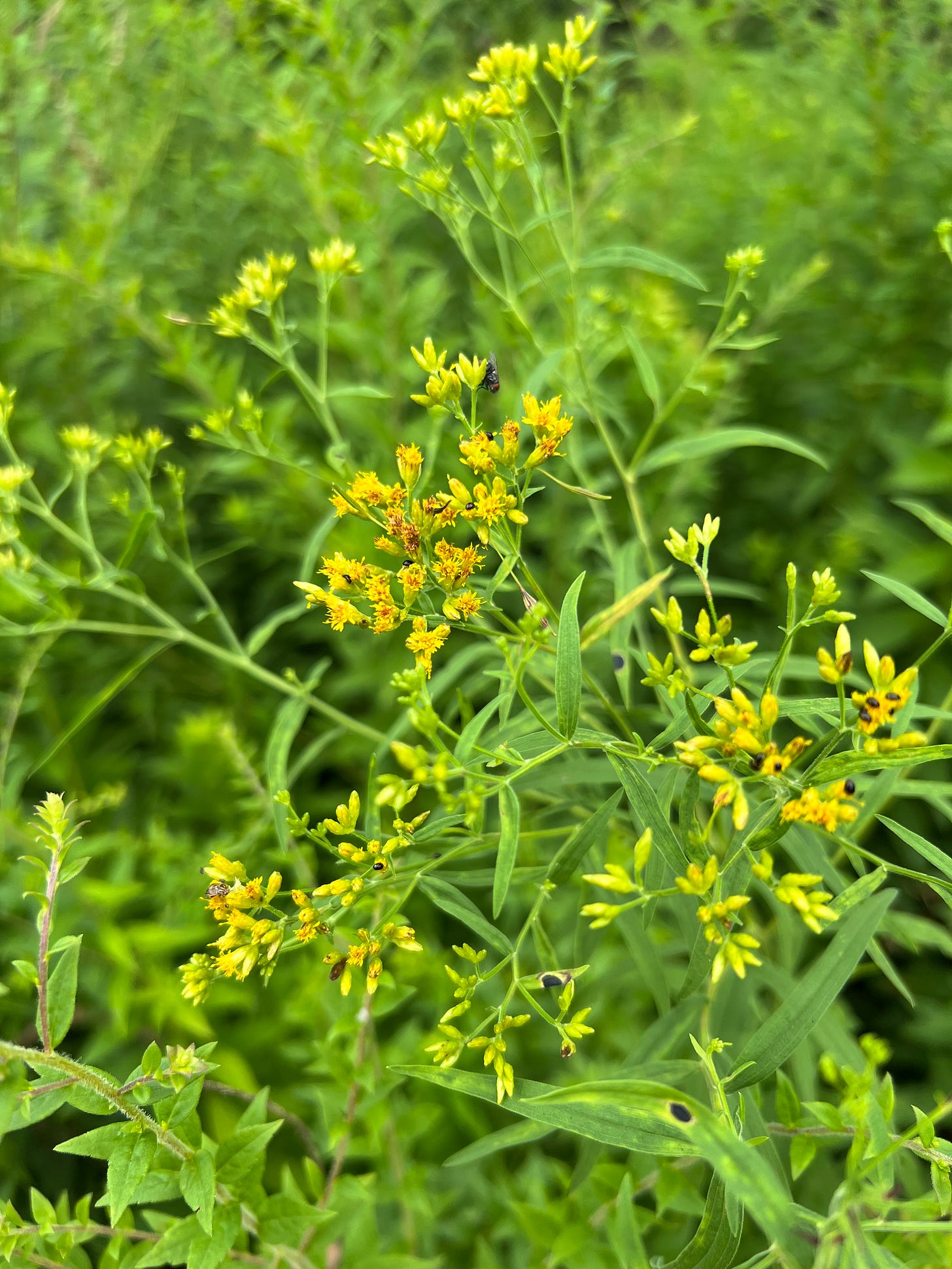
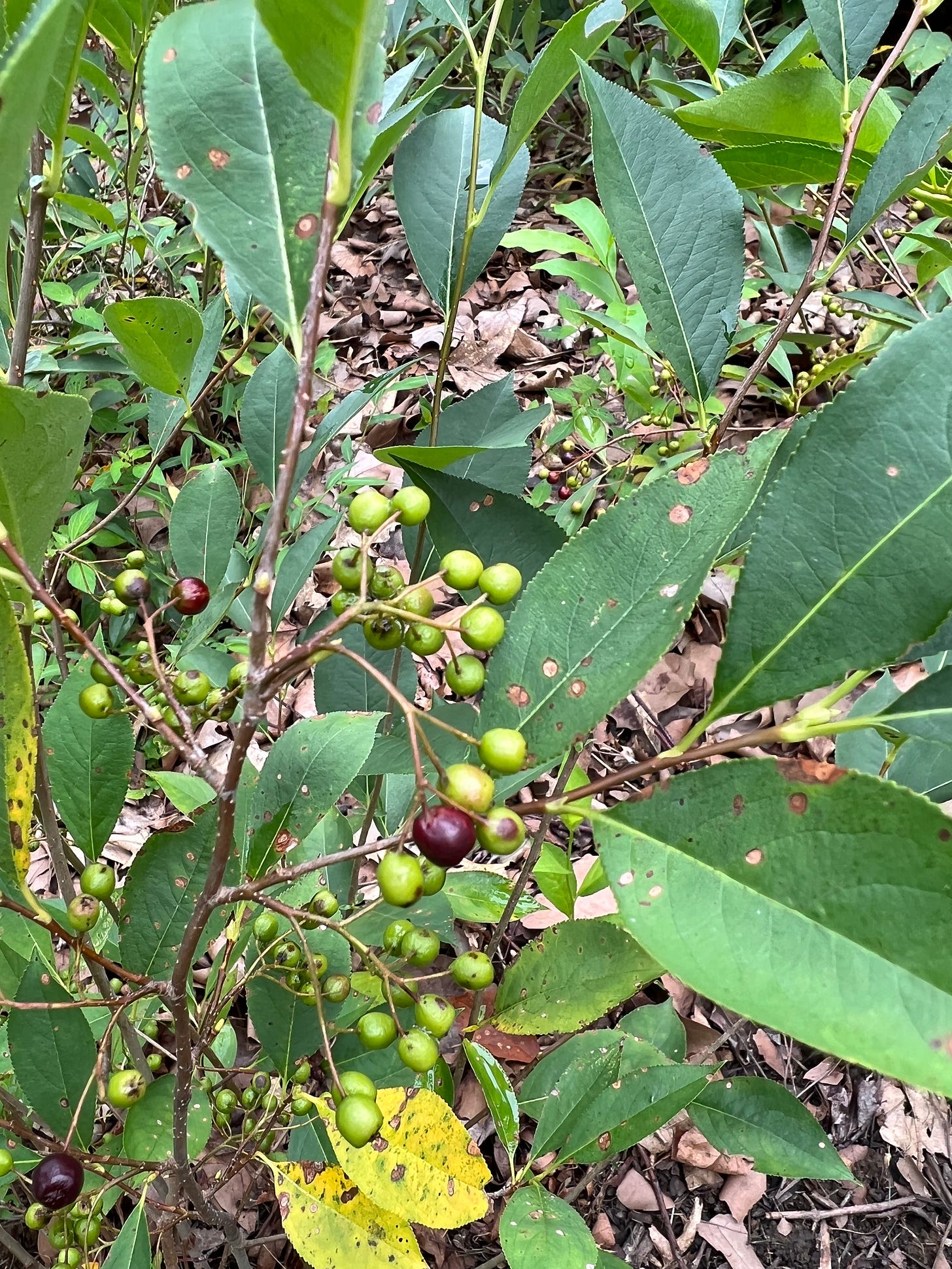
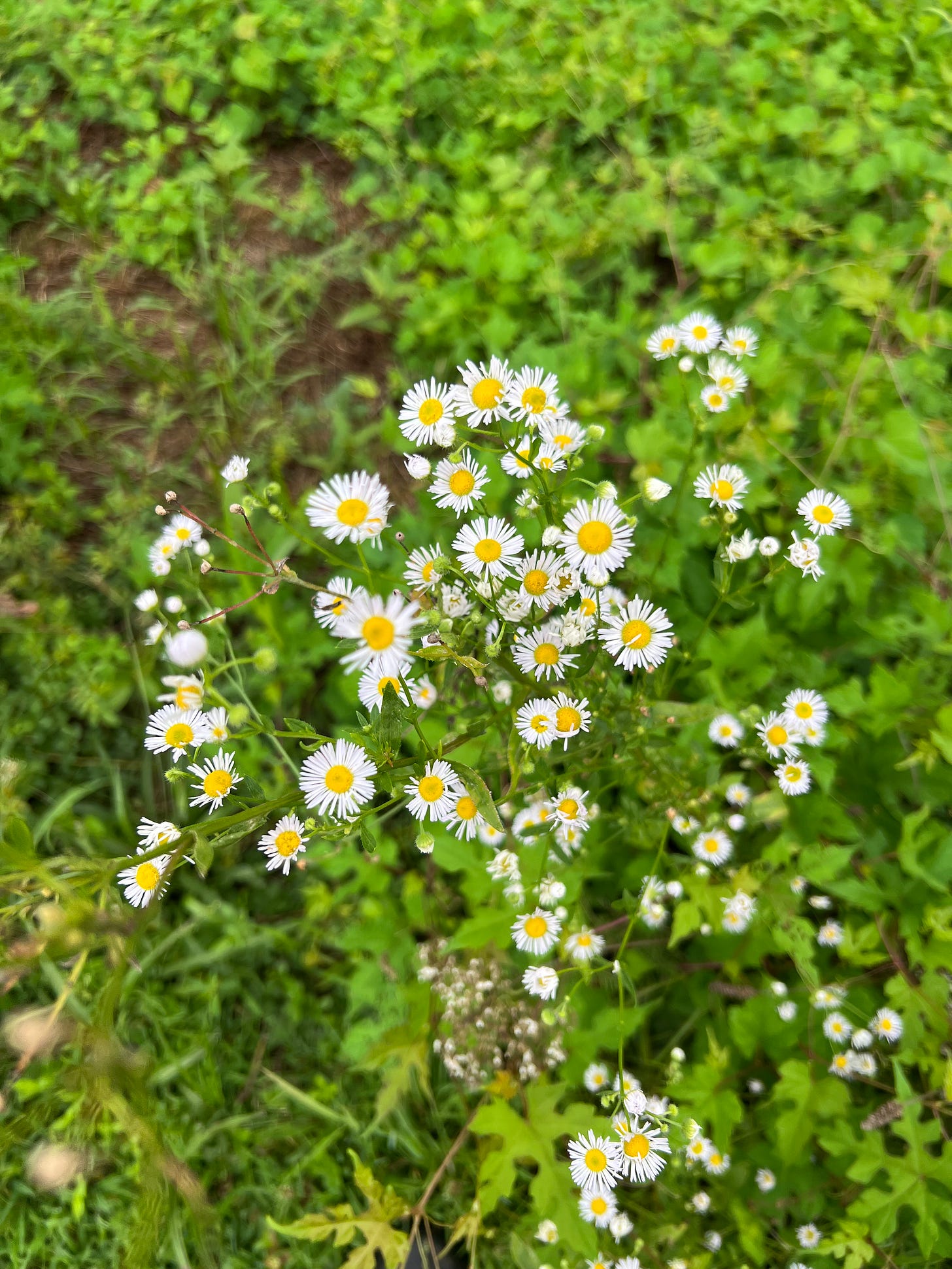

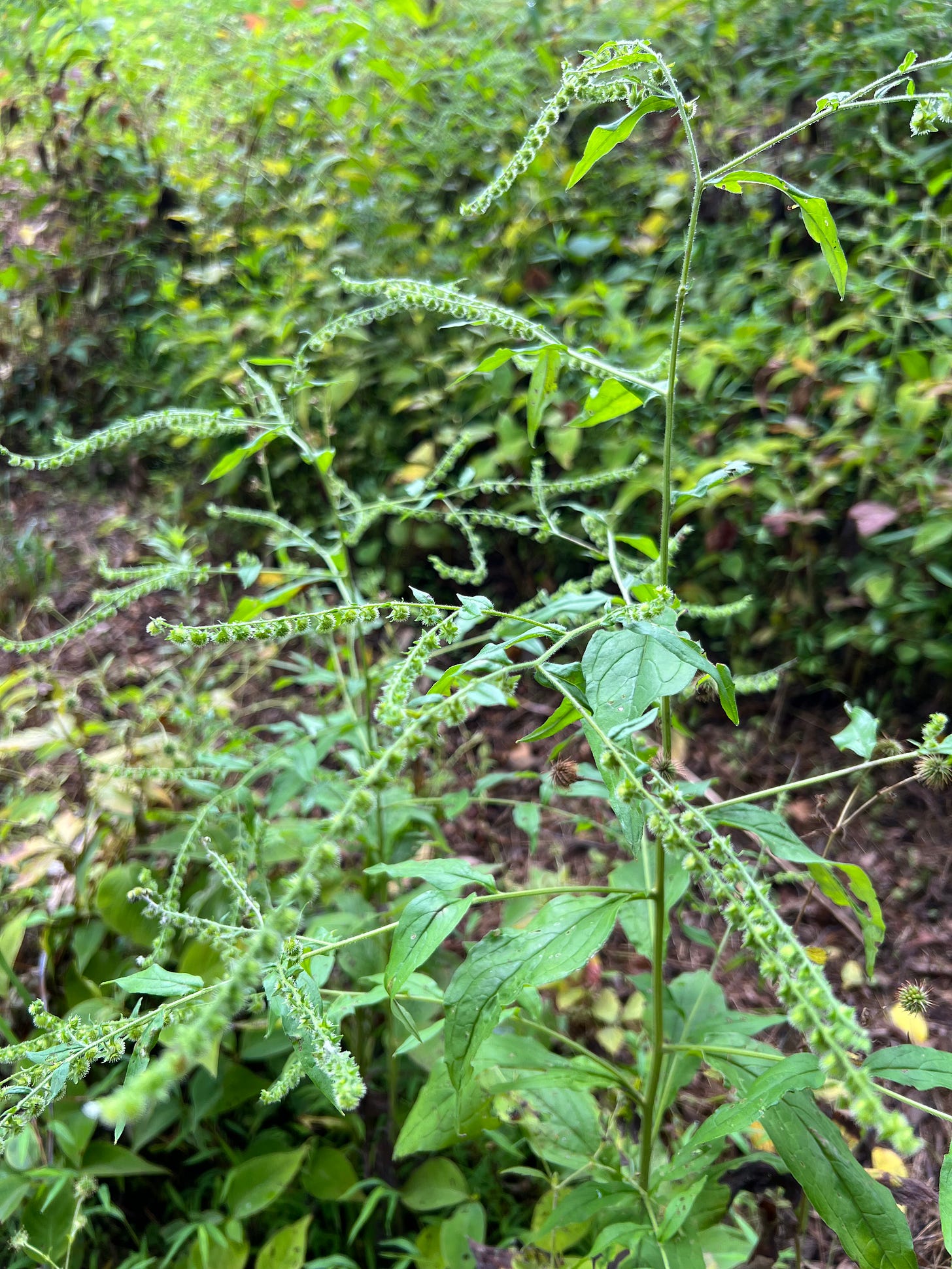
Thanks Joel, good motivation to be more mindful of what is around us…